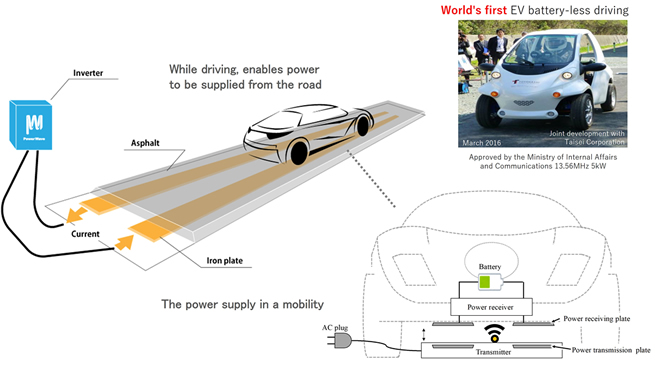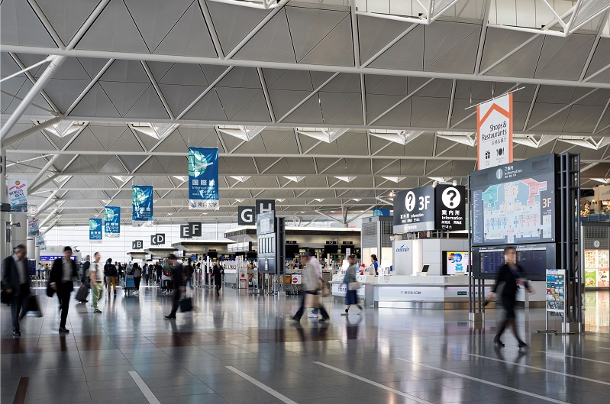
ここからコンテンツです。

Supporting the electrification of society through wireless power transfer
Shinji Abe

The electrification of automobiles and other vehicles is critical for the realization of carbon neutrality-the state of balance between the greenhouse gases emitted and absorbed. The current situation, however, is that battery-powered motors have a limited range, take a long time to recharge, and need to be connected to charging cables. Wireless power transfer is a technology capable of solving all of these problems at once. We interviewed Shinji Abe from Power Wave, a startup that originated at TUT aiming to build the key infrastructure of the future with this technology, about his reasons for starting the company and his vision.
Interview and report by Madoka Tainaka
Desire to solve battery challenges
"I chose National Institute of Technology (KOSEN), Sendai College after junior high school because I had learned that the largest part of the volume of a cell phone is occupied by batteries," said Abe. He aspired to produce smaller, more efficient batteries to achieve the futuristic world depicted in science fiction, from which he drew the inspiration to become a researcher.
"At first I entered the Department of Electronic Engineering to do research on batteries, but then I became interested in computer algorithms and architecture, so I switched to the Department of Information Engineering. After that, I returned to the study of electricity, and in graduate school I went to after graduating from the KOSEN Advanced Course, I joined the laboratory of Prof. Takashi Ohira at Toyohashi University of Technology, who was working on wireless power supply for electric vehicles (EVs).
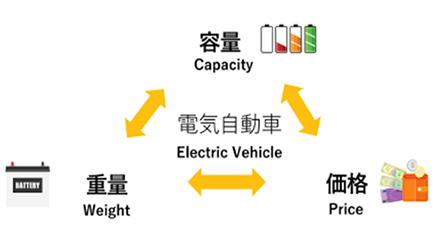
Gasoline-powered vehicles using fossil fuels are still currently the most common vehicles. However, with carbon neutrality being pushed as a solution to the limited supply of fossil fuels, it is reasonable to expect that energy-efficient EVs will become the standard for vehicles in the future. However, the current situation is that increasing battery capacity in order to increase driving range means increasing the weight and price of vehicles. In order to avoid such compromises, we need to build a system that supplies electricity only when it is needed. "One solution is the technology for wirelessly transferring power to moving vehicles," said Abe, explaining the significance of his research.
Launching a business is one way to change society
Abe reached a turning point in his path as a researcher while he was pursuing a doctorate. While conducting joint laboratory research with private companies, he started to appreciate the high level of demand for this technology from society. It seemed to him that researchers like himself and the other lab members were best placed, in terms of their understanding of the technology, to play a key role in how it should be applied to society.
"Once we started to try to raise funds for a university corporate partnership, I came to understand that our hands were tied by being part of the university structure. What is more, having been awarded a Research Fellowship for Young Scientists by the Japan Society for the Promotion of Science at that time, I was not allowed to take on any side businesses. In conclusion, I decided to leave the doctoral program, to take a position as a research assistant, and then to officially start setting up a business.
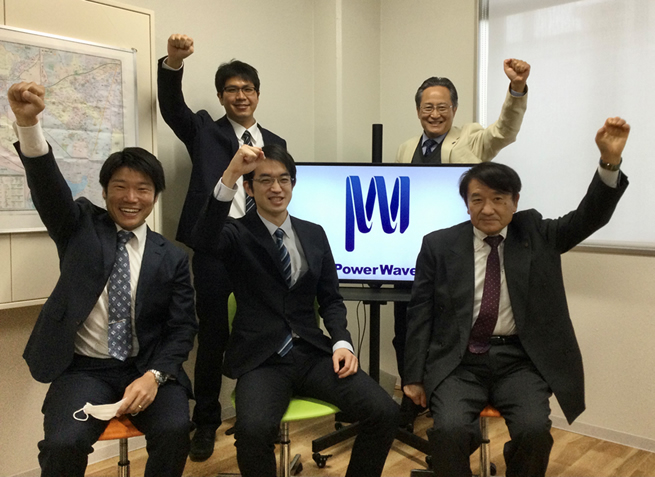
Thus Power Wave Co., Ltd. was established in March 2021, with the 29 year old Abe as its CEO. The four founders of the company are: Abe, Professor Takashi Ohira, Project Research Assistant Minoru Mizutani, and Mr. Norito Oida, the CEO of an IT-related startup company in Toyohashi City. In other words, a team comprising expertise in technology, venture management and leadership "
Did you experience any doubts about making the leap from R&D into the business world?
"I drew some confidence from my own father, who decided to switch from being a salaried worker to the owner of his own business. On top of that, I could draw on the advice of Mr Taneda, with his experience as a senior manager, so it was an easy decision in the end. Of course, there was a lot I didn't know about business management and I had some difficulties at first, but the more I studied, the more I got into it.
Basically, launching a business is a means to an end. To achieve my goal of spreading this technology to change society, I chose to form a company. "This technology has the potential to drastically change society, and I want to be a part of that change," explains Abe enthusiastically.
The benefit of university created startups: Trust based on established research is key
As it happends, the idea of wireless power supply has been around for a long time. . The first conceptual model was the World System, a system for transmitting electricity globally without wires, It was the brainchild of inventor Nikola Tesla, who was active from the late 19th to the mid-20th century. The appeal of this idea endured, but it was not until 2007 that a research team from the Massachusetts Institute of Technology (MIT) succeeded in wirelessly transferring electricy over a two-meter distance to power a 60W light bulb. This achievement opened a new frontier, and great advancements have been made towards practical application over the last decade.
Abe explained, "the most significant technological breakthrough was the theory for wireless coupling which was developed by TUT. Technically speaking, this theory involves the kQ product (multiplication of "coupling coefficient “k" by "quality factor") and the Poincaré model (non-Euclidean geometry measurement). The theory has made it possible to design wireless power transfer using the coupling of electric fields whereas previously this had been considered problematic. Another key breakthrough was the development of field-effect transistors (FETs) using Gallium nitride (GaN) semiconductors. Thanks to these FETs, the high-frequency inverter that converts direct current into large, very high frequency (MHz) electrical current was created."
This design theory using the coupling of electric fields and a high-frequency inverter are the core technologies behind Power Wave.
The credentials of this technology, an EV using a wireless power transfer system (or V-WPT: Via-Wheel Power Transfer) , have already been established. In 2016, while Abe was still a student, high-frequency power was successfully transmitted from a power transmission board underneath an asphalt road on campus to an EV equipped with a small battery and a receiver. This success marked the first batteryless drive in the world. In 2017, the following year, the laboratory also succeeded in transferring power to an unmanned, moving transport vehicle in a factory. Thus, Power Wave was firmly established with proven technologies.
"We were able to establish the company after more than a decade of research in our laboratory and with a good prospect of profitability. This is what makes us different from ordinary ventures. We have also obtained a number of patents under the university’s name. As a university-originated company, it has been easier for us to gain the trust of society. In the future, in order to grow I think it will be essential for us to create our own research department”
We set our sights high, and aim to become a company with market value over 1 trillion yen
Starting in October 2021, Power Wave commenced verification experiments with a personal mobility vehicle (a one-passenger powered cart) in Chubu Centrair International Airport. In this experiment, our wireless power transfer system will be incorporated into a personal mobility vehicle developed by Aisin (ILY-Ai), which will be used by airport staff. Up until now, charging has been done by cable, but by replacing it with a wireless system, it gives us a chance to see how it performs and to troubleshoot issues as they arise.
"If its user-friendliness is verified, we will be able to expand its use to facilities where similar mobility vehicles are used. Although it will be necessary to install high-frequency inverters and power transmission boards in the facilities, as well as power receivers in the mobility devices, the system can be retrofitted relatively easily, so I think it will be widely used not only in airports but also in plants, commercial facilities, hospitals, and other places where mobility and robots have already been introduced.”
If the system becomes widely accepted, the company is considering establishing a business model with fees based on electricity usage or a flat-rate subscription, rather than to the marketing of the system itself.
Mr. Abe says, "We aim to become a company with a market capitalization of more than one trillion yen, assuming that we can expand our business globally and use the system in electric vehicles by around 2030.” This is a very encouraging prospect. "As a manager, it's a huge advantage to be able to confidently explain the technology yourself. If students from Toyohashi University of Technology become business managers, they can similarly use their understanding of science and technology as their strength. It is my sincere hope that younger students will be inspired to follow a similar path."
References
- TUT originated startup company “Power Wave” established for wireless power transfer technology for vehicles and robots, TUT Research No.25 - Pick Up, May 2021
- "Resonance Q Theory"-A Breakthrough Discovered by TUT, TUT Research No.11 - Research Highlit, Dec 2017
- A new measure for wireless power transfer, TUT Research No.3 - Reserch Highlight, Nov 2015
Reporter's Note
Our first impression of Mr. Abe talking on the screen was of a researcher who cautiously selected his words. Towards the end of the interview, however, we could see a different side of him when he was talking about studying abroad as a student at KOSEN (National Institute of Technology). He took a year off from KOSEN and chose to study abroad in Brazil.
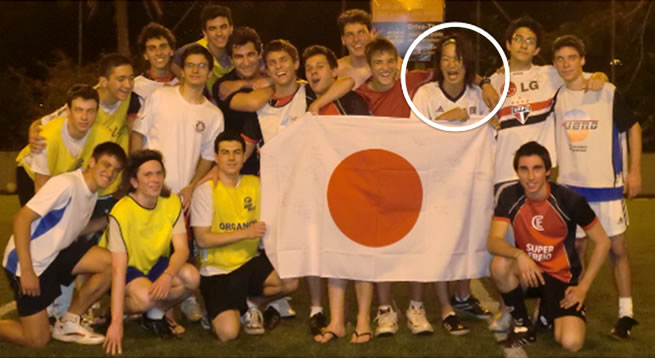
"I thought that if I was going to go abroad, I might as well go to the farthest country from Japan. Many of the Brazilians I met were open-minded and fond of Japan, and I was also happy to learn Portuguese," said Abe. On top of this experience, he had a six-week internship in Bahrain, Saudi Arabia, and the UAE in the Middle East. "I hope that my work allows me the possibility to visit many more places in the future," said Abe cheerfully. We predict a bright future for this young business manager and his can-do spirit.
「ワイヤレス給電」で電動化社会を支える
阿部 晋士
温室効果ガスの排出量と吸収量を均衡させようという「カーボンニュートラル」の実現には、自動車をはじめとするモビリティの電動化が欠かせない。しかし現状は、「バッテリーによるモーター駆動では走行距離が限られる」「充電に時間がかかる」「充電ケーブルにつなぐ必要がある」といった課題がある。これらを一気に解決してくれるのがワイヤレス給電技術だ。この技術を携えて、未来の基幹インフラの構築をめざす大学発ベンチャー「パワーウェーブ」の阿部晋士さんに、起業の理由や展望を聞いた。
バッテリーの課題を解決したい
高校進学に際し、仙台高等専門学校を選んだのは、携帯電話の体積の大部分を占めるのがバッテリーだと知ったからだと語る阿部さん。バッテリーをより小さく高効率にしてSFに描かれるような未来の世界を実現したい、というのが研究者を志すきっかけになった。
「高専では最初、電池の研究をしようと電子工学科に入ったのですが、途中からコンピュータのアルゴリズムやアーキテクチャが面白くなって情報工学科へ転科しました。その後、ふたたび電気の研究に戻り、高専の専攻科卒業後は、電気自動車(EV :Electric Vehicle)へのワイヤレス給電の研究をされている豊橋技術科学大学・大学院の大平孝先生の研究室の門戸を叩きました。
現在はまだ化石燃料を使うガソリン車が主流ですが、化石燃料には限りがあり、カーボンニュートラル政策が押し進められるなかで、今後はエネルギー効率のいいEVに急速に置き換わっていくと考えられます。しかし現状は、走行距離を伸ばそうとバッテリーの容量を増やせば車両重量が増え、価格も上昇してしまいます。このトレードオフを解消するために、必要なときに必要な分だけ電気を供給するしくみが必要です。その一つの解が走行中のワイヤレス給電技術というわけです」と、阿部さんは研究の意義を語る。
起業は社会を変えるための一つの手段
研究者として歩んできた阿部さんに転機が訪れたのは、博士後期課程のときだ。研究室で企業との共同研究を担当するなかで、この技術が社会から強く求められていることを実感し、最先端技術のことを一番よくわかっている自分たち研究者の立場から、社会に広めていきたいという思いを強く抱いたという。
「さまざまな企業との協業や、新しいビジネスモデルを提案して資金調達をしようとしたときに、大学の立場では動きづらいと感じていました。しかし当時は、日本学術振興会の特別研究員に採用されていて、副業・兼業が認められていませんでした。その後、博士課程を中退して助手の職に就いてから、起業に向けて本格的に準備を始めました」
こうして2021年3月、株式会社パワーウェーブを創立。29歳の阿部さんが代表取締役に就任した。発起人は、阿部さんのほか、大平孝特任教授、水谷豊特任助手、豊橋市でITベンチャー企業を経営している種田憲人(おいだのりひと)さんの4人だ。つまり、技術の専門家とベンチャー経営のプロ、そして技術のことをよく理解している若きリーダーがタッグを組んだことになる。
とはいえ、研究開発からビジネスの世界に飛び込むのに迷いはなかったのだろうか ―。
「サラリーマンから個人事業主へ転身した父親の存在が後押しになったのかもしれません。また、経営者の先輩である種田さんからさまざまに助言をいただいていたこともあって、迷いはありませんでした。もちろん、経営については知らないことだらけで最初は苦労もありましたが、勉強していくうちにどんどん興味が湧いてきました。
そもそも、起業はあくまでも手段です。技術を広めて社会を変えたいという目的を達成するため選んだのが、起業だったというだけ。この技術は社会を大きく変えるだけの力があるし、社会を支える縁の下になりたいという思いで事業に臨んでいます」と、阿部さんは意気込みを語る。
研究成果と信頼が大学発ベンチャーの強み
ところで、ワイヤレス給電の着想自体は以前からあったのだという。古くは、19~20世紀半ばに活躍した発明家、ニコラ・テスラが提唱した全地球規模の送電システム「地球システム」まで遡る。以来、人類の夢の技術として追究されてきた。その後、2007年にマサチューセッツ工科大学の研究グループが約2m離れた位置に置いた60Wの電球にワイヤレスで給電し、点灯させることに成功。これを皮切りに、ここ十数年の間に実用化へ向けて大きく進展してきた。
「技術の一番のブレークスルーは、本学が構築したワイヤレス結合理論です。この理論は少し専門的になりますが、kQ積(結合係数とQファクタの積)およびポアンカレ規範(非ユークリッド幾何学の計量)からなります。これにより従来は困難とされていた電界結合方式ワイヤレス給電の設計が可能となりました。もう一つは窒化ガリウム半導体による電界効果トランジスタが開発されたことです。これにより、直流電流をメガヘルツという非常に高い周波数で大きな電力へと高効率に変換する、高周波インバータを実現できるようになりました」と阿部さん。この電界結合方式設計理論と高周波インバータが、パワーウェーブのコア技術である。
すでにワイヤレス給電システムを使ったEVの走行も実証済みだ。阿部さんが学生だった2016年に、大学構内のアスファルト路面に埋設された送電板から高周波の電気を送り、小型バッテリと受電器を積んだEV車で受電、世界初のバッテリレス走行に成功した。翌17年には、工場内の無人搬送車の走行中の給電にも成功している。つまりパワーウェーブはすでに確立された技術を携えて、満を持して設立されたことになる。
「すでに研究室で十数年に渡って研究をしてきた成果があり、収益の見通しが立ってから設立することができました。そこが、通常のベンチャーとは大きく異なる私たちの利点でしょう。また、大学名義で多数の特許も取得していますし、大学発ということで社会的な信頼も得やすい。もっとも今後は、自社内に研究部門もつくっていくことが企業としての成長に欠かせないと思っています。
目標は大きく、1兆円企業をめざす
パワーウェーブは、2021年10月から中部国際空港のパーソナルモビリティ(一人乗りの電動カート)を活用した実証実験も開始した。これはアイシンが開発したILY-Ai(アイリーエーアイ)にワイヤレス給電システムを搭載するというもので、空港の職員が使用するカートを使った試みだ。これまでは有線での充電だったが、無線に置き換えることで利便性や課題を検証していく。
「使い勝手がいいと確かめられれば、同様のモビリティを使っている施設にも横展開できるでしょう。施設への高周波インバータや送電板の設置、モビリティへの受電器の搭載などは必要になりますが、比較的簡単にシステムを後付けできることから、空港に限らず、プラントや商業施設、病院など、すでにモビリティやロボットの導入が進む現場で広く活用していただけると思います」
利用が広がってきたら、システム自体を売るのではなく、電気使用量に応じた課金、もしくはサブスク(定額制)のビジネスモデルを構想しているという。
「グローバルにも展開し、2030年頃には電気自動車への利用も広がることを想定して、時価総額1兆円を超える企業をめざします」と阿部さん。頼もしい限りだ。
「自信を持って自分で技術について説明できるというのは、経営者として非常に大きな利点です。技科大生が経営者になれば科学技術を武器にできる。後輩たちにもぜひ、後に続いてほしいですね」
References
- 豊橋技術科学大学発 スタートアップ企業 「Power Wave」 を設立, TUT Research No.25 - Pick Up, May 2021
- ワイヤレス給電の実現を支えるTUT発の 「共鳴Q理論」, TUT Research No.11 - Research Highlit, Dec 2017
- A new measure for wireless power transfer, TUT Research No.3 - Reserch Highlight, Nov 2015
取材後記
最初、画面越しにお話をした阿部さんは、慎重に言葉を選ぶ研究者の顔に見えた。ところが取材の終盤、高専時代の留学の話におよぶと、意外な一面が見えてきた。高専を一年休学して留学先に選んだのはブラジルだったのだという。
「せっかく海外に行くなら一番遠くの国がいいなと思ったからです。ブラジルの人たちはオープンで親日家も多く、ポルトガル語も習得できました」と阿部さん。さらに、6週間のインターンシップでは、中東のバーレーンやサウジアラビア、UAEで働いた。「今後もビジネスでさまざまな場所に行ってみたいですね」 と阿部さんは明るく語る。
チャレンジ精神旺盛な若き経営者の活躍に、今後も大いに期待しています。
(取材・文=田井中 麻都佳)
Researcher Profile
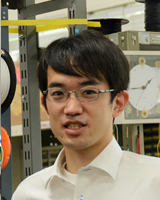
Shinji Abe
Shinji Abe graduated from Advanced Course of National Institute of Technology (KOSEN), Sendai College and entered to Toyohashi University of Technology (TUT) Graduate School in 2015. During TUT student, he awarded Research Fellowship for Young Scientists by the Japan Society for the Promotion of Science from 2018 to 2019. After graduated, he started working as a project research associate at TUT in 2019. He established Power Wave Co., Ltd. in March 2021 and became the CEO.
Reporter Profile

Madoka Tainaka is a freelance editor, writer and interpreter. She graduated in Law from Chuo University, Japan. She served as a chief editor of "Nature Interface" magazine, a committee for the promotion of Information and Science Technology at MEXT (Ministry of Education, Culture, Sports, Science and Technology).
ここでコンテンツ終わりです。

